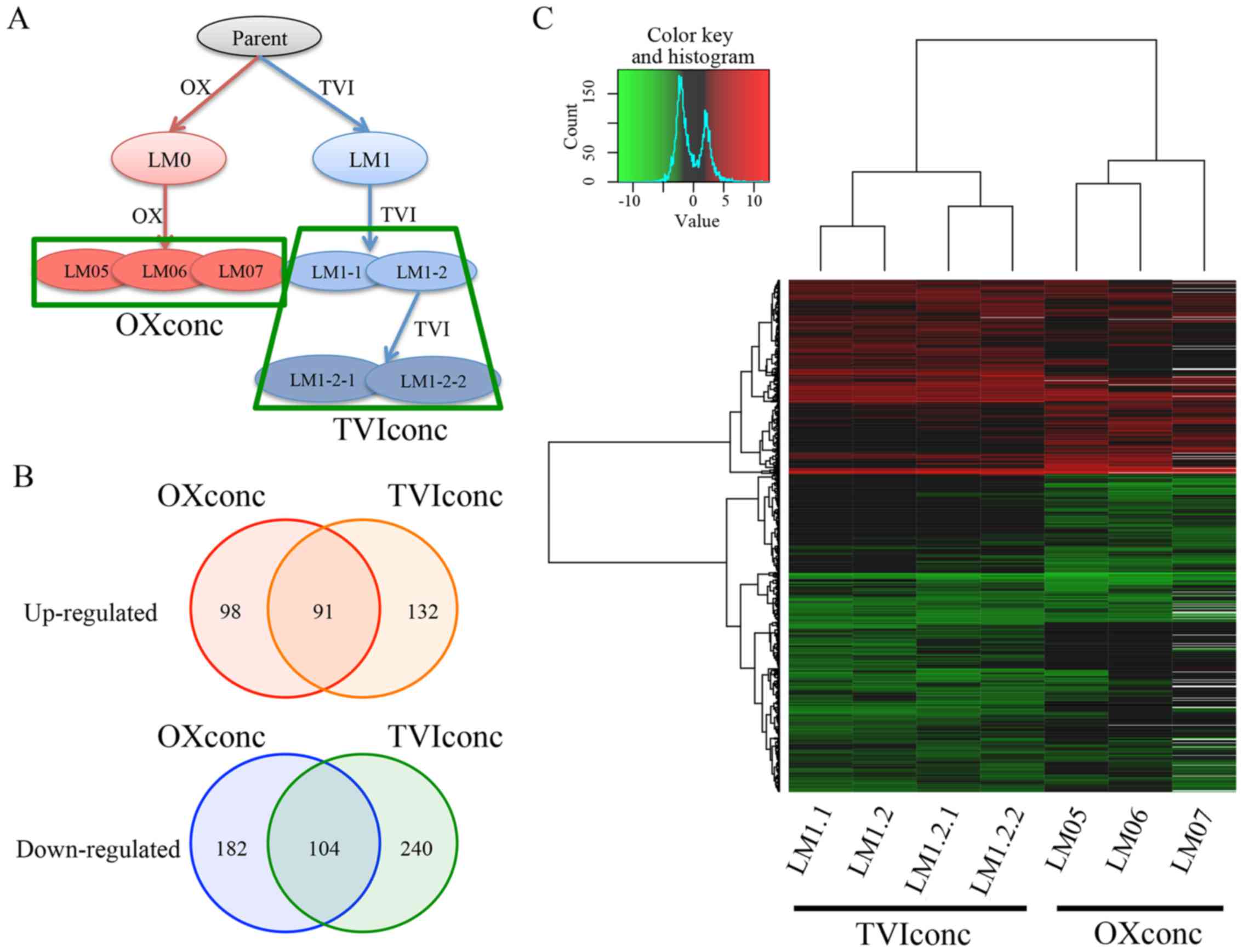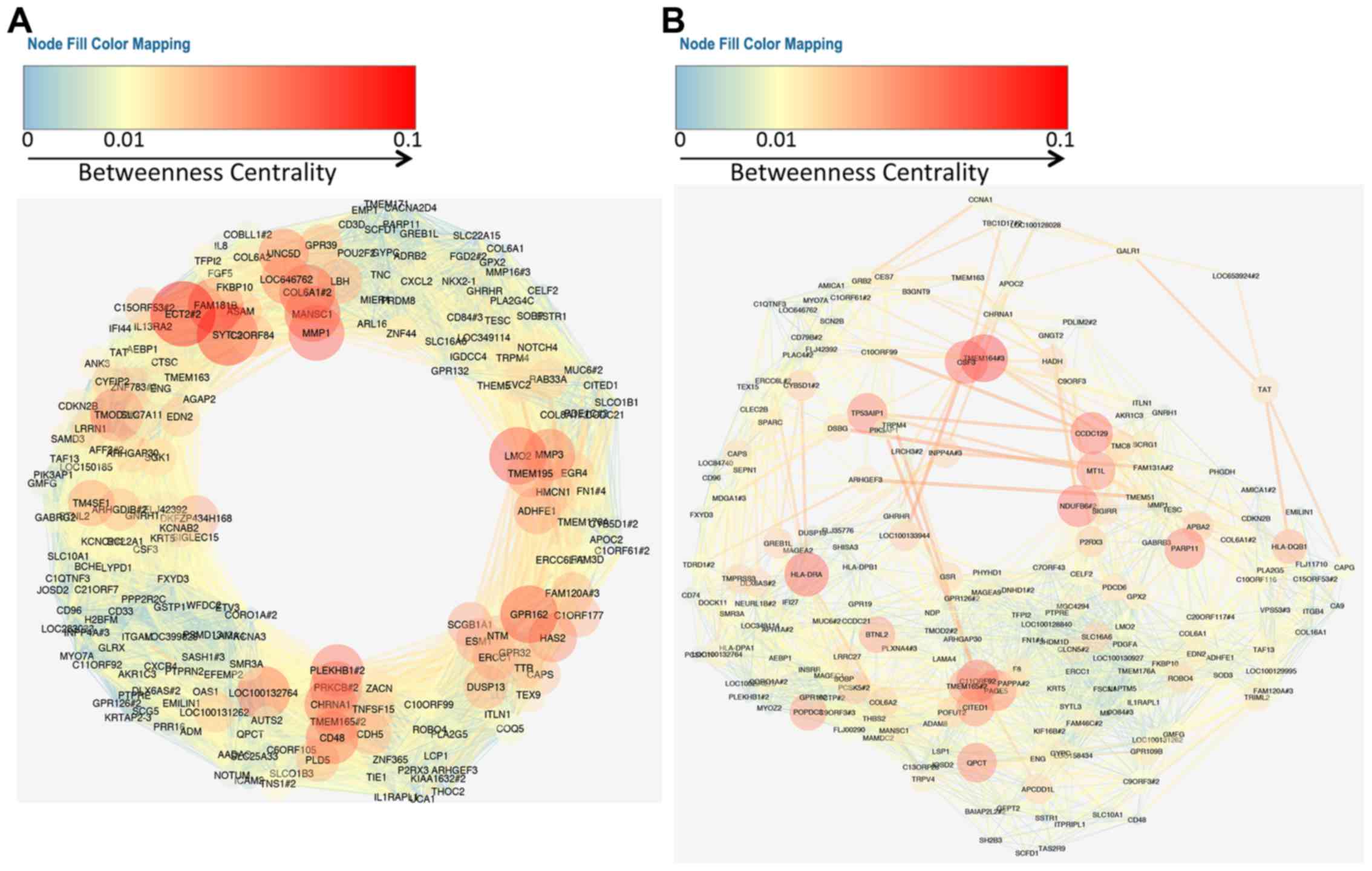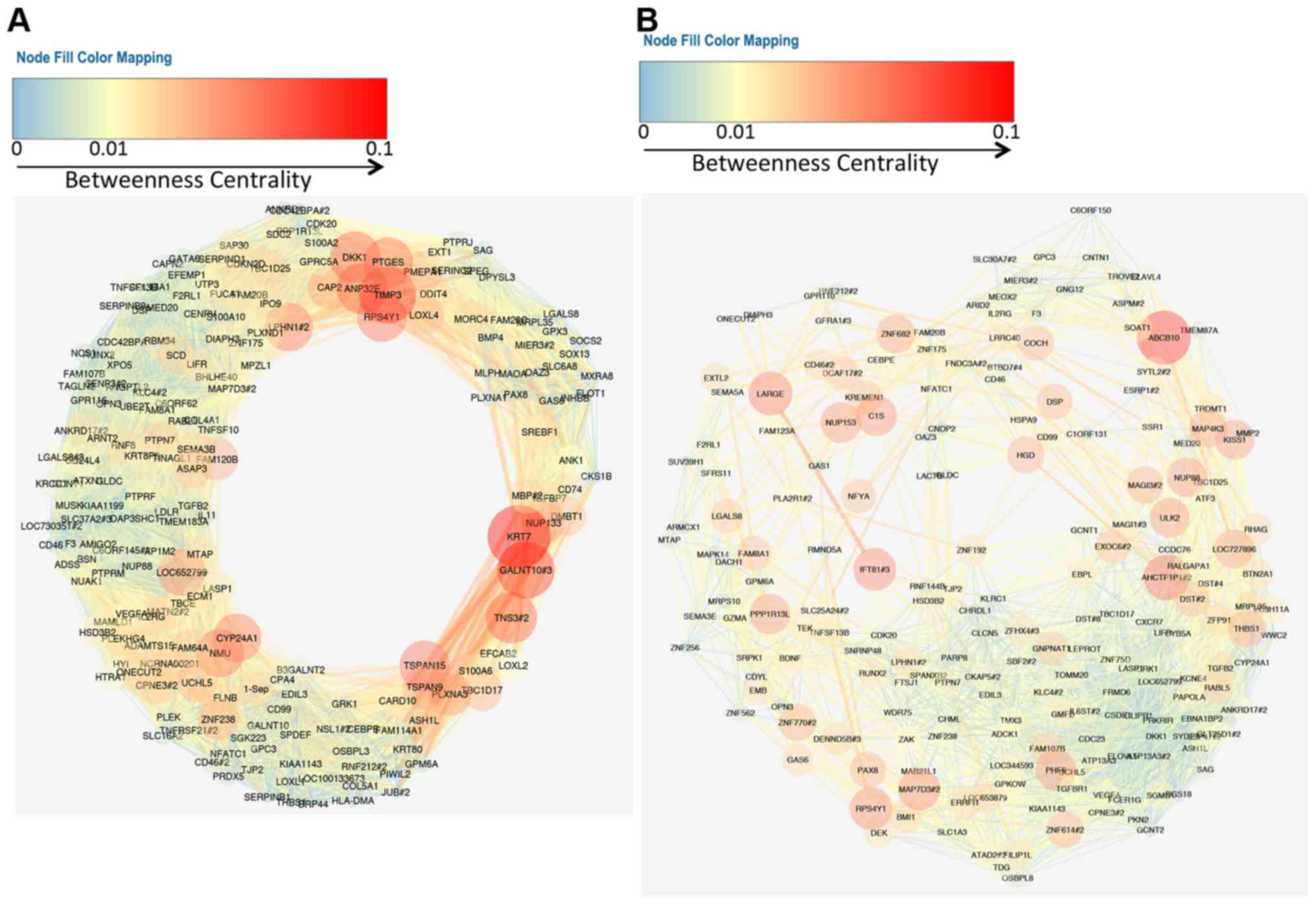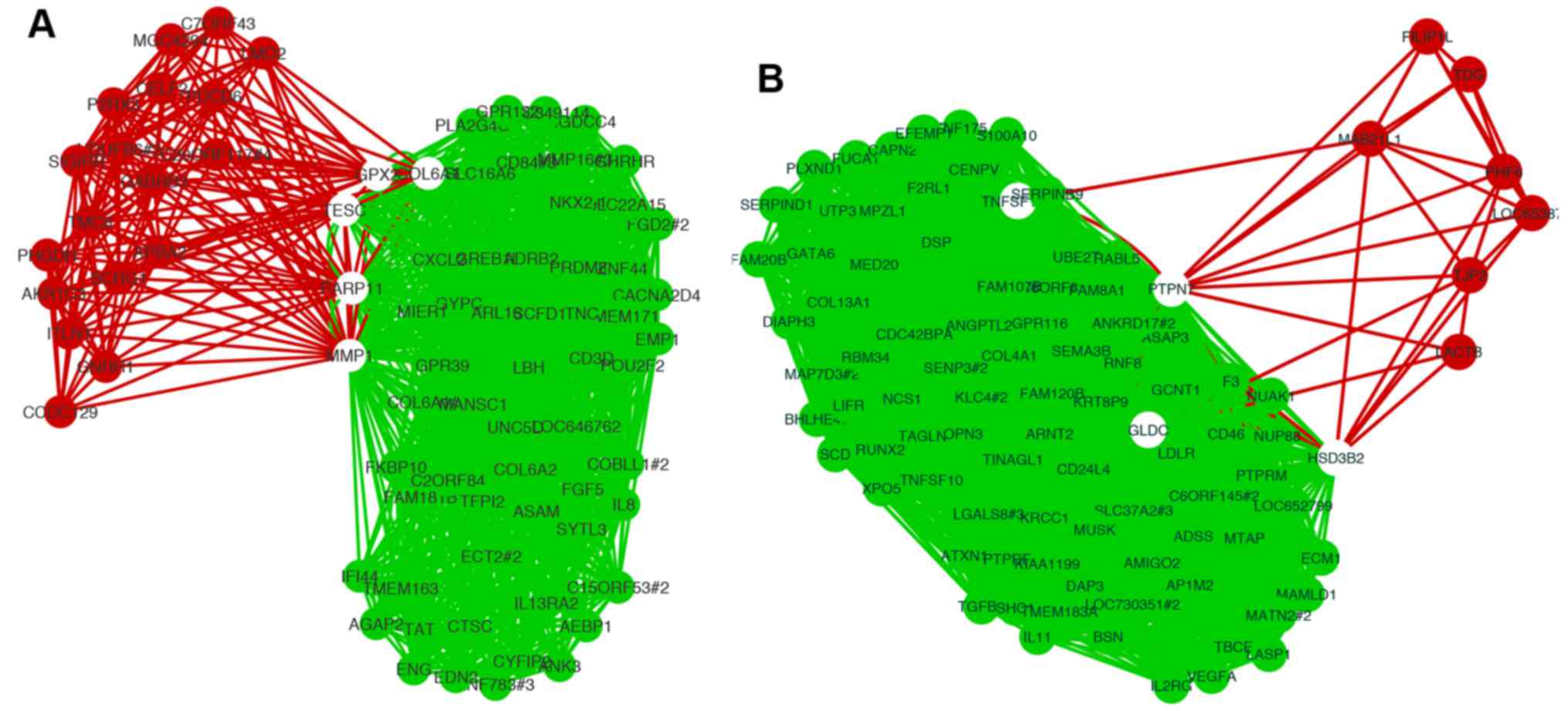Comparative analysis of gene regulatory networks of highly metastatic breast cancer cells established by orthotopic transplantation and intra-circulation injection
- Authors:
- Published online on: December 16, 2016 https://doi.org/10.3892/ijo.2016.3809
- Pages: 497-504
Abstract
Introduction
Most metastatic cancer cannot be cured with current treatment. Thus, understanding the biological mechanism of metastasis is critical for development of effective clinical treatment. The invasion-metastasis cascade consists of: i) invasion into local tissue and induction of angiogenesis/lymphanginogenesis; ii) intravasation; iii) survival in the circulation; iv) arrest at a distant organ site; v) extravasation; vi) micrometastasis formation; and vii) metastatic colonization. Metastatic process is believed to be driven by metastasis genes that are involved in at least one of these steps (1). Metastasis signature genes and metastatic organ tropism have been analyzed in clinical studies by transcriptomic analysis using DNA microarrays (2–5). Previous studies showed that some metastasis signature genes are involved in specific steps of the invasion-metastasis cascade (6–8). In some cases of metastasis genes, co-activation with other genes was required for metastasis in distant organs (6).
The human breast carcinoma cell line MDA-MB-231 is an ideal tool for metastatic study because it exhibits metastatic activities to distant organs by the xenograft model using immunodeficient mice. For example, the intra-cardiac injection method produced metastases to lung, bone and brain, whereas, the tail vein injection (TVI) method metastasizes to lung because injected cells tend to be trapped in the lung (5). Highly metastatic cells can be established by repetition of recovery of cancer cells from metastatic lesions followed by their injection into blood vessels. In the present study, we refer to this procedure as 'concentration of metastatic activities'. Organ specific-metastatic signature genes were previously identified by transcriptomic analysis in highly metastatic cancer cells (3,5,9).
In the orthotopic xenograft (OX) model, tumor cells are injected into organs from which they are derived. In the case of breast cancer, the tumor cells are transplanted into the fat pad. Transplanted breast cancer cells form primary tumors and metastases to lung and bone, as well as liver and lymph node (3,10,11). Therefore, the OX model mimics the overall steps of the invasion-metastasis cascade in contrast to the TVI method, which only mimics the steps after extravasation.
In the present study we generated highly metastatic cell lines using the OX or TVI method and compared both gene expression profiles to determine the characteristics of early steps of metastasis, including local invasion and leaking out into vessels.
Materials and methods
Cell culture
MDA-MB-231 cells (ATCC, Manassas, VA, USA) were cultured in RPMI-1640 (Wako Pure Chemical Industries, Ltd., Osaka, Japan) supplemented with 10% heat-inactivated fetal bovine serum (FBS), 100 µg/ml streptomycin (Meiji Seika Pharma Co., Ltd., Tokyo, Japan) and 100 U/ml penicillin (Meiji-Seika Pharma) at 37°C with 5% CO2. Plat-E and 293T cells were cultured in DMEM (Wako Pure Chemical Industries) supplemented with 10% heat-inactivated FBS, 100 µg/ml streptomycin and 100 U/ml penicillin at 37°C with 5% CO2. MDA-MB-231-EcoR cells were generated by infection of MDA-MB-231 cells with recombinant lentivirus (pLenti6-PUbc-mSlc7a1-HygR; Addgene, Cambridge, MA, USA) and selection by 800 µg/ml hygromycin (Wako Pure Chemical Industries). MDA-MB-231-EcoR-luc2 cells were generated by retroviral infection (pMXd3-PEF1-luc2-IRES-BlaR) and selection by 2.0 µg/ml blastcidin (Invitrogen/Thermo Fisher Scientific, Waltham, MA, USA). Plat-E cells for retroviral packaging were kindly provided by T. Kitamura (Institute of Medical Science, The University of Tokyo).
Viral infection
Lentiviral packaging was performed by co-transfection of pLenti6-PUbc-mSlc7a1-HygR (Addgene), HIV-based vectors including a cDNA expression cassette and the pPACK packaging plasmids (System Biosciences, Palo Alto, CA, USA). Plasmid DNAs were transfected into 293T cells by the calcium phosphate transfection method. The culture supernatant was harvested the following day and stored as virus stock. MDA-MB-231 cells were plated at a density of 2.5×105 cells/well in 12-well plates, followed by infection with 5-fold diluted lentiviral stock solution. After 18 h, virus solution was replaced with fresh culture media or passaged to new dishes. Plat-E cells were transfected with pMXd3-PEF1-luc2-IRES-BlaR by calcium phosphate transfection method. MDA-MB-231-EcoR cells (2.5×105 cells) plated in 12-well plates were infected with 5-fold retroviral stock solution for 24 h. After infection, the mixture was replaced with culture media or cells were passaged to a new dish.
Mouse xenograft metastasis model and bioluminescence imaging
NOD.CB-17-Prkdcscid/J mice (NOD-SCID; Charles River Laboratories Japan, Inc., Kanagawa, Japan) were used in xenograft models. For the TVI model, 5.0×105 cancer cells suspended in 100 µl D-PBS(−) (Wako Pure Chemical Industries) were injected using a 27-gauge needle into the tail vein. For the orthotopic xenograft model, 1.0×106 cancer cells in 10 µl D-PBS(−) were implanted orthotopically using a 28-gauge needle into the fourth fat pads. Eight weeks after the injection, primary tumors were removed under anesthetized conditions with 2.5% isoflurane (Wako Pure Chemical Industries). After the primary tumors were removed, mice were periodically monitored for metastasis formation using an in vivo imaging system for 2–4 weeks.
Mice were intraperitoneally injected with 200 µl D-Luciferin (15 mg/ml; Gold Biotechnology, Inc., St. Louis, MO, USA) and 20–25 min later, luminescence and X-ray imaging were taken under anesthesia using an in vivo imaging system (IVIS Lumina XR3; Perkin-Elmer, Waltham, MA, USA). Animal experiments in this study were conducted under the approval of the Animal Committee of Waseda University.
Tumor cell isolation
Lung metastases removed from xenograft model mice were finely cut by scissors for dissection in 5 ml of culture medium in a 6-cm dish and incubated at 37°C with 5% CO2. After 2–3 days, cells invaded from sliced organs were sufficiently grown at the bottom of the dish and tumor-derived cells were selected by 2–3 passages in the presence of 2.0 µg/ml blastcidin to remove primary lung cells.
DNA microarray analysis
Total RNA extraction, RT-PCR and DNA microarray analysis were performed as described (12).
Statistical data analysis and network analysis
Statistical analyses of microarray data were performed using software packages obtained from Bioconductor (http://www.biocon-ductor.org/) and CRAN (https://cran.r-project.org/) with the R statistical programming language. Heatmap analyses were executed by 'ggplot2' and 'gplots' packages and graphical outputs in the form of Venn diagram were produced by 'GeneVenn' (http://genevenn.sourceforge.net/). DAVID (version 6.7; https://david.ncifcrf.gov/) (13) was used for GO (Gene Ontology) enrichment analysis. Gene regulatory network analyses were performed using 'igraph' package. Network visualization and topological analysis was generated by Cytoscape ver.3.2.0. (http://www.cytoscape.org/) (14–16).
Results
Establishment of highly metastatic cell lines and gene expression analysis
MDA-MB-231-luc2 cells were transplanted into NOD-SCID mice using either OX or TVI methods. Lung metastasis (LM) cells were recovered and established from lung metastatic lesions. LM cells were then re-injected into NOD-SCID mice using the same method to concentrate cells with higher metastatic activity (Fig. 1A). Established cell lines exhibited higher metastatic activities to lung than the parental cell line (data not shown).
We next analyzed gene expression profiles of LM cell lines using cDNA microarrays and calculated the fold change (FC) ratio of gene expression for each concentrated LM cell line vs. parental cell line. We converted the FC ratios to z-scores and selected genes that showed z-score >2.0 as metastasis signature genes. As a result, 189 genes were upregulated and 286 genes downregulated in the signature of OXconc (OX concentration), while 223 genes were upregulated and 344 genes downregulated in the signature of TVIconc (TVI concentration). Analysis of these genes by hierarchical clustering and Venn plot demonstrated that gene expression profiles were different between OXconc and TVIconc, even though both LM cell lines are derived from an identical cell line (Fig. 1B and C and Table I).
GO analysis and gene regulatory network analysis
To evaluate the signature genes expressed in each metastatic cell line, we next examined enrichment terms of the biological process categories in GO by DAVID annotation tools (Table II). In the OXconc signature, genes associated with cell proliferation were repressed, while genes associated with cell adhesion and chemotaxis were upregulated. In the TVIconc signature, genes associated with antigen recognition were enriched in addition to those with cell adhesion.
For gene regulatory network analysis, we focused on correlations of gene expression patterns in each concentrated metastatic cell line. We calculated each gene-gene Pearson's correlation coefficient in each methodological metastatic cell line using gene expression data. We performed network analysis using Cytoscape for network visualization and topological analysis. To display the gene regulatory network, we focused on the top 200 genes of the metastasis signature genes. We selected gene-gene correlations in which the correlation coefficient value is >0.9 and displayed network with betweenness centrality using yFiles organic layout (Figs. 2 and 3). Intriguingly, both the OXconc gene regulatory network of upregulated genes and that of downregulated genes formed circle network topologies.
Among the common genes observed in the upregulated gene regulatory network, a well-known metastasis gene, matrix metalloproteinase 1 (MMP1), showed the highest z-score. We extracted the sub-network related to MMP1 from each network (Fig. 4A). The sub-network of MMP1 in the OXconc network had more edges and nodes than that in the TVIconc network. Sub-networks of protein tyrosine phosphatase non-receptor type 7 (PTPN7), which showed the lowest z-score in common downregulated genes, also showed the same feature (Fig. 4B).
To evaluate the significance of genes encoding transcription factors such as hub genes, we extracted genes categorized as 'GO:0003700~ transcription factor activity, sequence-specific DNA binding' in the molecular function (Table III). Contrary to expectations, betweenness centrality of transcriptional factors had low values in these gene regulatory networks (data not shown).
Discussion
Discovery of novel metastasis genes can help to understand the metastatic mechanisms and establishment of prognostic markers (17). Lung metastasis genes in breast carcinoma were previously identified by transcriptome analysis of metastatic cancer cells and patient metastases using DNA microarray and by gene knockdown experiments in highly metastatic cancer cells. However, the roles of some metastasis genes have not been analyzed in detail.
MMP1 was most highly expressed gene in OXconc and TVIconc networks. Previous research suggested that MMP1 activity alone was not enough for metastasis to lung and MMP1 requires other metastasis genes to promote metastases in the lung (6). In our studies, the OXconc network revealed a group of genes whose expressions highly correlated with MMP1 expression. These genes may cooperate with MMP1 to contribute to lung metastasis. The CXCR4 (C-X-C chemokine receptor type 4) gene was expressed in only the OXconc signature. Expression of CXCR4 in metastatic cancer cells highly expressing CXCL12 (C-X-C chemokine motif ligand 12) enhanced metastasis to distant organs, such as lung, liver and bone marrow. Thus, CXCR4 in breast cancer is believed to decide the metastatic organ tropism (18,19). In our studies, expression of CXCR4 may not be necessary to form a pre-metastatic niche and metastatic colonization. Instead, CXCR4 may especially regulate the early metastatic phase, namely invasion from primary tumor. Expression of interleukin 8 (IL8) promotes angiogenesis and metastasis to distant organs in an orthotopic xenograft model (20). Consistently, upregulation of IL8 was observed in the OXconc signature. However, in this and others studies, IL8 was not found in metastasis signature genes by the intra-circulation model using MDA-MB-231 cells (3,5). Our findings suggest that some important metastasis signature genes may have been missed in the previous analysis using intracirculation injection methods. Thus, establishing highly metastatic cell lines by different methods will lead to novel insights into invasion-metastasis mechanisms and help identify novel metastatic genes.
Shedding of tumor cells into the circulation occurs at the early stage of metastasis. Circulating tumor cells (CTCs) that survive in the circulation and spread in the whole body are likely necessary for distant organ metastasis (21). In fact, the number of CTCs in breast cancer patients is associated with prognosis (22). In GO analysis, the terms 'cell adhesion' (23) and 'cell chemotaxis' were enriched in OXconc, while 'chemotaxis' was not enriched in TVIconc. CTCs require the abilities of chemotaxis and cell adhesion with vascular endothelial cells for homing in distant organs (22). Thus, our results confirm the role of genes involved in chemotaxis and cell adhesion for metastasis to distant organs.
A gene regulatory network analysis method using gene expression data is most commonly used for comparative genomic data. Analysis to examine the relationship between regulatory network and phenotype is important to discover novel markers and understand disease mechanisms (24,25). In previous studies, interference of hub genes in networks showed that a hub gene and its neighbor genes regulate the biological phenotype. For example, the hub genes MYOG (myogenin) and CTNNA2 [catenin (cadherin-associated protein) alpha 2] in a transcriptional network of muscle satellite cells promote myoblast differentiation (26). The metastasis gene BACH1 (BTB and CNC homology 1) was found by transcriptional network analysis of cancer cell lines using DNA microarrays (27). Although these genes do not have transcriptional activity, they contributed to the biological phenotype as hub genes of the network. We used betweenness centrality to extract hub genes. In our network, most genes of core nodes do not encode transcription factors. Thus, the molecular links and their biological importance between hub genes and neighbor genes remain to be revealed.
In network analysis, the focus on similarities and differences of correlation is an important strategy (28). Common regulated genes in OXconc and TVIconc may be of importance in the invasion-metastasis cascade and could be cancer prognosis markers. Among the common genes observed in upregulated gene regulatory networks, CITED1 (Cbp/p300-interacting transactivator) may also be a metastasis marker of breast cancer, because it is a known marker of lymph node metastasis in colorectal carcinoma (29). Differential network analysis is now becoming prevalent as a tool to more comprehensively interrogate biological systems in a variety of organisms (30).
Comparative analysis of the sub-network of common genes in OXconc and TVIconc showed that the OXconc sub-network had a closer relationship than the TVIconc. Previous research in lung cancer showed that the MMP1-MMP3-MMP12 gene cluster on chromosome 11q22 plays important roles in prognosis and metastasis (31). In our studies, the sub-network of MMP1 revealed MMP1-MMP3 correlation in the OXconc network. This finding suggests that some relationships of metastasis genes have been missed in previous analyses using intra-circulation injection methods.
To display gene regulatory networks, we used the yFiles organic layout algorithm on the basis of the force-directed paradigm. These structurally different regions of a organic network can be identified by looking at the produced drawing (32). Our findings demonstrated that the OXconc networks showed a circle structure. Circle topologies suggest that genes involved in metastasis may have complementary relationships at the gene community level and have the potential for strong robustness.
In the present study, we performed transcriptional profiling of highly metastatic cell lines established by two different methods: the orthotopic transplantation method and intra-circulation method. Although these metastatic lines are derived from an identical cell line, gene expression profiles and gene regulatory networks were different in OXconc and TVIconc signatures, suggesting that those cell lines were activated at different steps of the invasion-metastasis cascade. Our findings will contribute to the understanding of the detailed metastatic mechanisms and development of therapeutics or diagnostic tools.
Acknowledgments
We thank our laboratory members for valuable discussion. The present study was conducted in part as a program through the Fukushima Translational Research Project and was supported in part by JSPS KAKENHI (grant no. 23241064), Grant-in-Aid for Scientific Research (A) and MEXT-Supported Program for the Strategic Research Foundation at Private Universities.
References
|
Valastyan S and Weinberg RA: Tumor metastasis: Molecular insights and evolving paradigms. Cell. 147:275–292. 2011. View Article : Google Scholar : PubMed/NCBI | |
|
van de Vijver MJ, He YD, van't Veer LJ, Dai H, Hart AA, Voskuil DW, Schreiber GJ, Peterse JL, Roberts C, Marton MJ, et al: A gene-expression signature as a predictor of survival in breast cancer. N engl J Med. 347:1999–2009. 2002. View Article : Google Scholar : PubMed/NCBI | |
|
Minn AJ, Gupta GP, Siegel PM, Bos PD, Shu W, Giri DD, Viale A, Olshen AB, Gerald WL and Massagué J: Genes that mediate breast cancer metastasis to lung. Nature. 436:518–524. 2005. View Article : Google Scholar : PubMed/NCBI | |
|
Van Veer LJ, Dai H, Van De Vijver MJ, Van Der Kooy K, Marton MJ, Witteveen AT, Schreiber GJ, Kerkhoven RM, Roberts C, Bernards Â, et al: Gene expression profiling predicts clinical outcome of breast cancer. Nature. 415:530–536. 2002. View Article : Google Scholar | |
|
Minn AJ, Kang Y, Serganova I, Gupta GP, Giri DD, Doubrovin M, Ponomarev V, Gerald WL, Blasberg R and Massagué J: Distinct organ-specific metastatic potential of individual breast cancer cells and primary tumors. J Clin Invest. 115:44–55. 2005. View Article : Google Scholar : PubMed/NCBI | |
|
Gupta GP, Nguyen DX, Chiang AC, Bos PD, Kim JY, Nadal C, Gomis RR, Manova-Todorova K and Massagué J: Mediators of vascular remodelling co-opted for sequential steps in lung metastasis. Nature. 446:765–770. 2007. View Article : Google Scholar : PubMed/NCBI | |
|
Oskarsson T, Acharyya S, Zhang XH, Vanharanta S, Tavazoie SF, Morris PG, Downey RJ, Manova-Todorova K, Brogi E and Massagué J: Breast cancer cells produce tenascin C as a metastatic niche component to colonize the lungs. Nat Med. 17:867–874. 2011. View Article : Google Scholar : PubMed/NCBI | |
|
Padua D, Zhang XH, Wang Q, Nadal C, Gerald WL, Gomis RR and Massagué J: TGFbeta primes breast tumors for lung metastasis seeding through angiopoietin-like 4. Cell. 133:66–77. 2008. View Article : Google Scholar : PubMed/NCBI | |
|
Bos PD, Zhang XH, Nadal C, Shu W, Gomis RR, Nguyen DX, Minn AJ, van de Vijver MJ, Gerald WL, Foekens JA, et al: Genes that mediate breast cancer metastasis to the brain. Nature. 459:1005–1009. 2009. View Article : Google Scholar : PubMed/NCBI | |
|
De Larco JE, Wuertz BR, Rosner KA, Erickson SA, Gamache DE, Manivel JC and Furcht LT: A potential role for interleukin-8 in the metastatic phenotype of breast carcinoma cells. Am J Pathol. 158:639–646. 2001. View Article : Google Scholar : PubMed/NCBI | |
|
Yang S, Zhang JJ and Huang XY: Mouse models for tumor metastasis. Methods Mol Biol. 928:221–228. 2012.PubMed/NCBI | |
|
Kato H, Honma R, Sanda T, Fujiwara T, Ito E, Yanagisawa Y, Imai J, Okamoto T and Watanabe S: Knock down of hSNF5/Ini1 causes cell cycle arrest and apoptosis in a p53-dependent manner. Biochem Biophys Res Commun. 361:580–585. 2007. View Article : Google Scholar : PubMed/NCBI | |
|
Huang DW, Sherman BT, Tan Q, Collins JR, Alvord WG, Roayaei J, Stephens R, Baseler MW, Lane HC and Lempicki RA: The DAVID Gene Functional Classification Tool: A novel biological module-centric algorithm to functionally analyze large gene lists. Genome Biol. 8:R1832007. View Article : Google Scholar : PubMed/NCBI | |
|
Shannon P, Markiel A, Ozier O, Baliga NS, Wang JT, Ramage D, Amin N, Schwikowski B and Ideker T: Cytoscape: A software environment for integrated models of biomolecular interaction networks. Genome Res. 13:2498–2504. 2003. View Article : Google Scholar : PubMed/NCBI | |
|
Saito R, Smoot ME, Ono K, Ruscheinski J, Wang PL, Lotia S, Pico AR, Bader GD and Ideker T: A travel guide to Cytoscape plugins. Nat Methods. 9:1069–1076. 2012. View Article : Google Scholar : PubMed/NCBI | |
|
Cline MS, Smoot M, Cerami E, Kuchinsky A, Landys N, Workman C, Christmas R, Avila-Campilo I, Creech M, Gross B, et al: Integration of biological networks and gene expression data using Cytoscape. Nat Protoc. 2:2366–2382. 2007. View Article : Google Scholar : PubMed/NCBI | |
|
Talmadge JE and Fidler IJ: AACR centennial series: the biology of cancer metastasis: historical perspective. Cancer Res. 70:5649–5669. 2010. View Article : Google Scholar : PubMed/NCBI | |
|
Sun X, Cheng G, Hao M, Zheng J, Zhou X, Zhang J, Taichman RS, Pienta KJ and Wang J: CXCL12/CXCR4/CXCR7 chemokine axis and cancer progression. Cancer Metastasis Rev. 29:709–722. 2010. View Article : Google Scholar : PubMed/NCBI | |
|
Balkwill F: Cancer and the chemokine network. Nat Rev Cancer. 4:540–550. 2004. View Article : Google Scholar : PubMed/NCBI | |
|
Waugh DJ and Wilson C: The interleukin-8 pathway in cancer. Clin Cancer Res. 14:6735–6741. 2008. View Article : Google Scholar : PubMed/NCBI | |
|
Kim MY, Oskarsson T, Acharyya S, Nguyen DX, Zhang XH, Norton L and Massagué J: Tumor self-seeding by circulating cancer cells. Cell. 139:1315–1326. 2009. View Article : Google Scholar | |
|
Alix-Panabières C and Pantel K: Challenges in circulating tumour cell research. Nat Rev Cancer. 14:623–631. 2014. View Article : Google Scholar : PubMed/NCBI | |
|
Joyce JA and Pollard JW: Microenvironmental regulation of metastasis. Nat Rev Cancer. 9:239–252. 2009. View Article : Google Scholar : PubMed/NCBI | |
|
Gaiteri C, Ding Y, French B, Tseng GC and Sibille E: Beyond modules and hubs: The potential of gene coexpression networks for investigating molecular mechanisms of complex brain disorders. Genes Brain Behav. 13:13–24. 2014. View Article : Google Scholar | |
|
Lee WP and Tzou WS: Computational methods for discovering gene networks from expression data. Brief Bioinform. 10:408–423. 2009.PubMed/NCBI | |
|
Malik A, Lee EJ, Jan AT, Ahmad S, Cho KH, Kim J and Choi I: Network analysis for the identification of differentially expressed hub genes using myogenin knock-down muscle satellite cells. PLoS One. 10:e01335972015. View Article : Google Scholar : PubMed/NCBI | |
|
Liang Y, Wu H, Lei R, Chong RA, Wei Y, Lu X, Tagkopoulos I, Kung SY, Yang Q, Hu G, et al: Transcriptional network analysis identifies BACH1 as a master regulator of breast cancer bone metastasis. J Biol Chem. 287:33533–33544. 2012. View Article : Google Scholar : PubMed/NCBI | |
|
Bergmann S, Ihmels J and Barkai N: Similarities and differences in genome-wide expression data of six organisms. PLoS Biol. 2:E92004. View Article : Google Scholar : PubMed/NCBI | |
|
Nasu T, Oku Y, Takifuji K, Hotta T, Yokoyama S, Matsuda K, Tamura K, Ieda J, Yamamoto N, Takemura S, et al: Predicting lymph node metastasis in early colorectal cancer using the CITED1 expression. J Surg Res. 185:136–142. 2013. View Article : Google Scholar : PubMed/NCBI | |
|
Ideker T and Krogan NJ: Differential network biology. Mol Syst Biol. 8:5652012. View Article : Google Scholar : PubMed/NCBI | |
|
Sun T, Gao Y, Tan W, Ma S, Zhang X, Wang Y, Zhang Q, Guo Y, Zhao D, Zeng C, et al: Haplotypes in matrix metalloproteinase gene cluster on chromosome 11q22 contribute to the risk of lung cancer development and progression. Clin Cancer Res. 12:7009–7017. 2006. View Article : Google Scholar : PubMed/NCBI | |
|
LaPorte J and Varela C: Organic and hierarchical concentric layouts for distributed system visualization. RPI Comput Sci Tech Rep. 1–8. 2008. |













